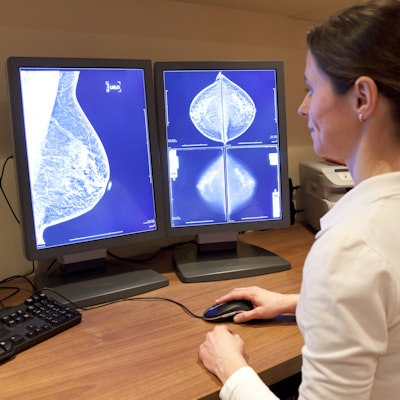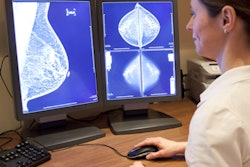
An artificial intelligence (AI) algorithm can sharply decrease the number of mammograms that require interpretation by radiologists -- without affecting diagnostic accuracy, according to research published online May 30 in the Journal of the American College of Radiology.
Researchers from the University of California, Los Angeles (UCLA) and the University of Cambridge in the U.K. developed a deep learning-based model called Autonomous Radiologist Assistant (AURA), which is designed to triage negative mammograms and enable radiologists to focus on reading uncertain and abnormal exams. In a proof-of-concept study, the researchers found that AURA could -- while maintaining 99% negative predictive value -- potentially reduce the number of negative screening mammograms that radiologists read.
"AURA provides a palatable solution for incorporating artificial intelligence into radiology that does not compete with the radiological practice but complements the workflow," wrote first author Trent Kyono, a doctoral student at UCLA, and colleagues.
Unlike other approaches in the literature that explored the use of convolutional neural networks (CNNs) to completely automate the process of reading mammograms and potentially replace the radiologist, the researchers sought to develop a triage system in which some mammograms are autonomously diagnosed as negative and the remaining studies are read by a radiologist. They trained AURA using mammograms from a research dataset of more than 7,000 women recalled for assessment at six U.K. National Health Service Breast Screening Program centers.
Emulating how radiologists read mammograms, a CNN first extracts imaging features and then predicts the diagnosis and radiological assessments for each of the four mammography views. Next, a deep neural network arrives at a patient-level diagnosis after considering nonimaging features as well as the CNN's predictions for each mammographic view. The system then makes its recommendation as to whether additional reading by a radiologist is needed.
The researchers assessed the performance of AURA on two types of datasets: one with 15% prevalence of cancer cases, as might be found in a diagnostic setting, and a second test set with 1% prevalence of cancer, as might be expected in a screening environment.
| Performance of AURA for detecting normal mammograms | ||
| Theoretical diagnostic setting (15% cancer prevalence) | Theoretical screening setting (1% cancer prevalence) | |
| Reduction in number of negative mammography exams that would need to be read by a radiologist* | 34% | 91% |
"Our findings suggest that the AURA system achieves this reduction by correctly classifying patients with attributes known to be associated with lower likelihoods of cancer, such as younger age and lower breast density, as breast cancer negative," the authors wrote.
The researchers believe that AURA could help radiologists in several ways. The system could be used to reduce the number of mammograms that radiologists need to read in a diagnostic setting and may also hold significant promise in screening mammography applications. What's more, it could also free up time for radiologists to focus on the difficult cases, potentially reducing the likelihood of misdiagnoses, according to the authors.




















